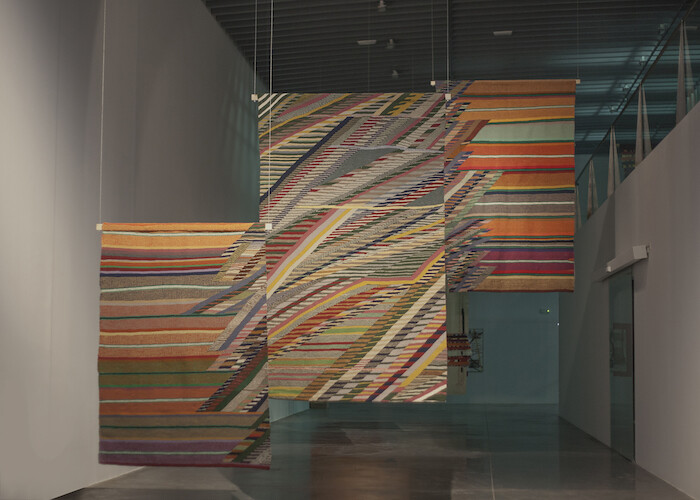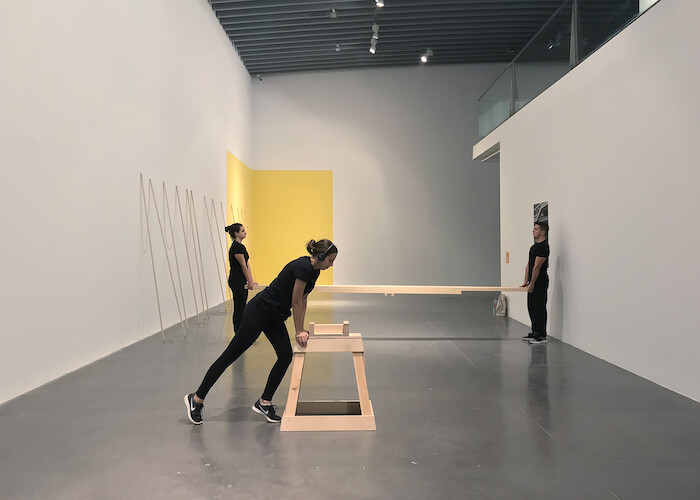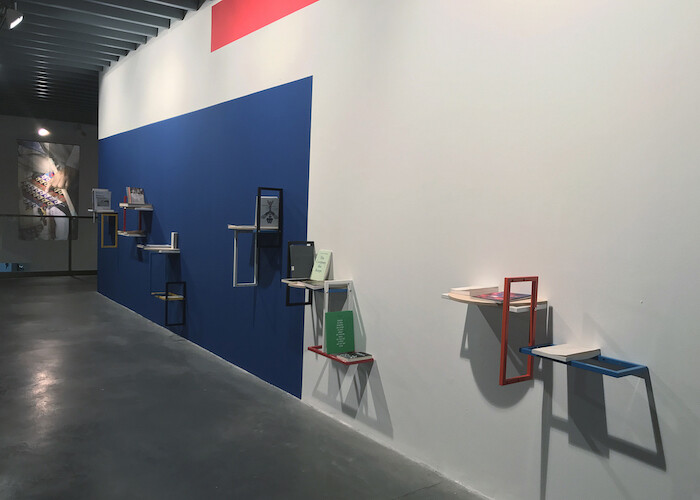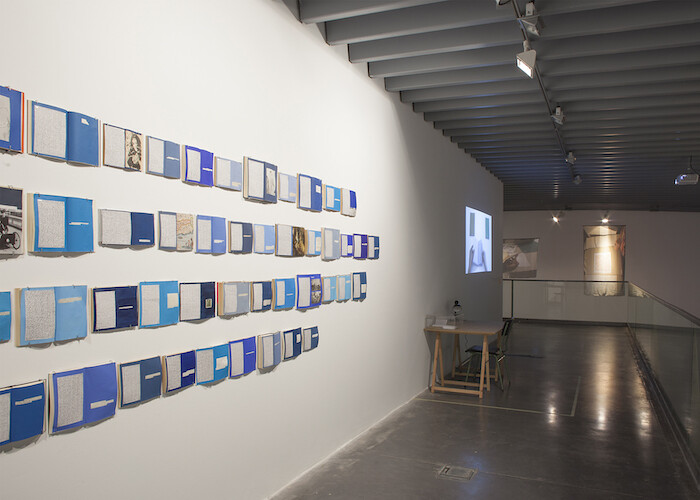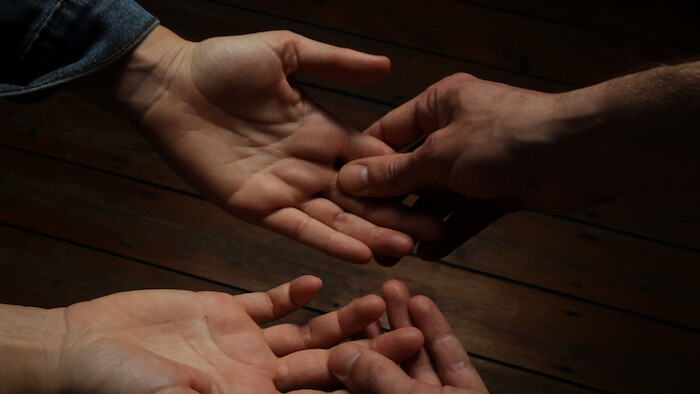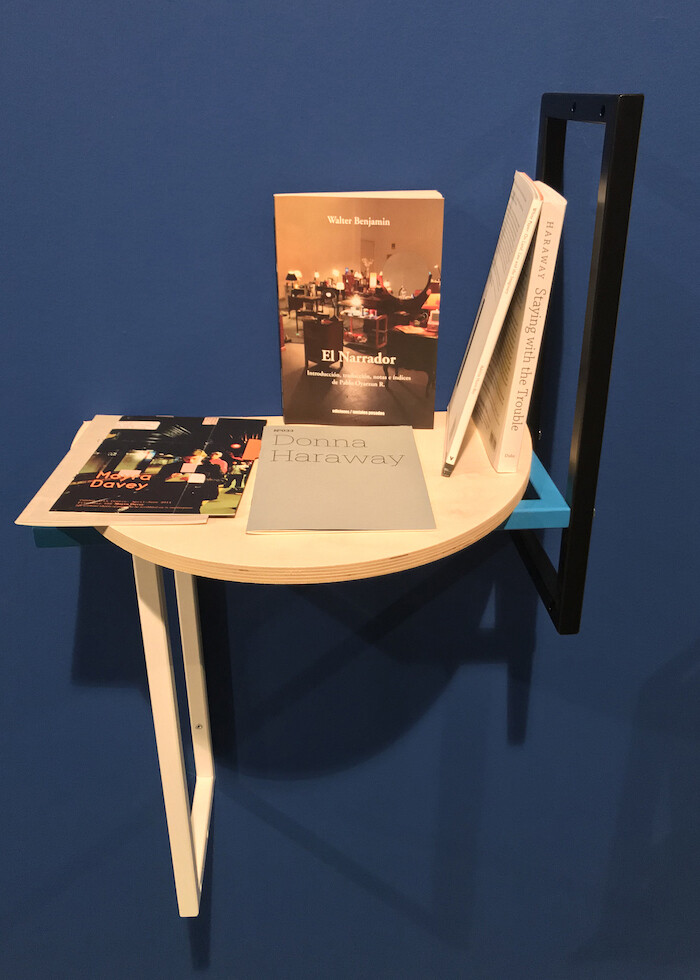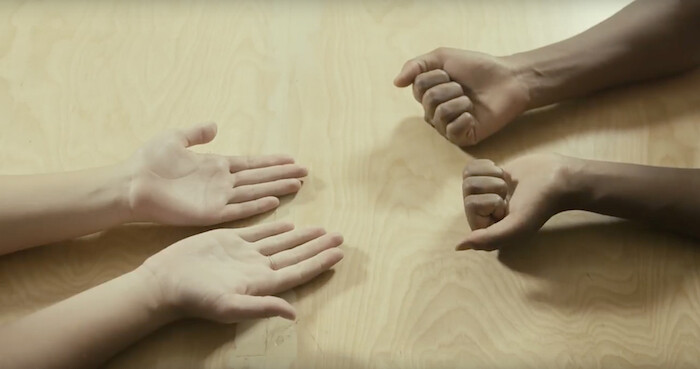October 26, 2018–February 17, 2019
Two pairs of hands play a game of cat’s cradle, forming a star from a loop of string; viewers may imagine one person pulling the string while the other interprets their instructions. This photograph, which appears on the cover of the booklet accompanying the group exhibition “Te toca a tí” [It’s your turn] at the Espai d’art contemporani de Castelló (EACC), epitomizes the exhibition’s conceptual framework. Curated by Laura Vallés Vílchez and including works by ten artists, the show asks whether a gallery can become a site of negotiation, and if so, in what ways it can be re-signified.
At the entrance are five striped tapestries and three sewn oil paintings made by Teresa Lanceta between 2003 and 2018. Hung from the double-height ceiling of the EACC, they generate a labyrinthine opening to the exhibition. Further inside the gallery, the white walls are partly painted in primary colors to indicate which works the public are invited to interact with. Luca Frei’s Simone Forti’s See-Saw (2015) and Sticks and Chains (2010) are perhaps the most playful of these. The latter consists of 13 wooden sticks measuring 240 centimeters each leaning against a yellow wall, joined at both ends by thin chains of the same length. Visitors are perhaps encouraged to play with their position (and disposition), carefully circling other works in the gallery or surrounding other gallery goers. First performed in December 1960 by Yvonne Rainer and Robert Morris, Forti’s See Saw was one of her “Dance Constructions”—her term for works she defined as both performances and sculptures, in which performers improvised gestures and formations according to given rules. At the opening of the EACC exhibition, Frei’s reactivation of Forti’s work began with performers carrying a plywood plank from one corner of the gallery to a wooden pivot located to the side. Once brought together, the sculptural elements formed a seesaw. Three performers from a local theater school variously climbed up and slid down the seesaw’s slanted surface, stood together at the center while trying to find balance, and briskly but carefully levered each other’s bodies. With its deceptively simple choreography of negotiation, Simone Forti’s See-Saw embraces and battles with gravity’s inevitable grip on the fate of the performers’ encounter and the pace of their relationship to the object. During the event, a young boy in the audience repeatedly asked his mother when the activity would finish. Once it was over, he exclaimed in relief: “Now it’s my turn!”
What happens if bodies are out of sync or disconnected? In Adelita Husni-Bey’s video After the Finish Line (2015), a group of young American athletes openly discuss the limits of their bodies, the emotions they deal with when injured, and the realization that what pushes them to be the best “also causes [them] to crash down and break,” as one confessed. Two more works further explore the intricacies of self-negotiation. Ludovica Carbotta’s sound piece Monowe (A Conversation) (2016–ongoing) imagines a parallel dimension, called Monowe, with a single inhabitant. The work’s surreal fictional dialogue comprises an interview the character conducts with themselves, staged via two loudspeakers placed in the EACC bar: this body is constantly redefining its boundaries, both physical and existential. A similar open-ended methodology runs through Alex Reynolds’s video Ver Nieve [To See Snow] (2016): its soundtrack comprises dialogues between an elusive protagonist and a series of interlocutors, who discuss the script of a future, unmade film.
While Carbotta and Reynolds’s works position the self as the subject of endeavor, Céline Condorelli’s Models for a Qualitative Society (2016), which includes a group of colorful spinning tops placed on the floor and four framed inkjet prints of archival documentation and text, highlights historical and social case studies. The artist’s research drew on three utopian visions of public playgrounds realized by architects during the 1960s: Palle Nielsen in Stockholm, Aldo van Eyck in Amsterdam, and Lina Bo Bardi in São Paulo. Another pedagogical model plays out in Husni-Bey’s 2011 video Postcards from the Desert Island. Centering on a three-week workshop with a group of children from a self-run elementary school in Paris, it vividly documents how they imagine, negotiate, and ultimately decide how to govern their school-hall-turned-desert-island. Both works explore forms of human interaction that might, as Condorelli’s title suggests, help build a more equitable society.
“Te toca a tí” fits together cohesively, yet at times takes sharp turns. Moyra Davey’s “Copperheads” (1990–ongoing), a series of close-up photographs of one-cent coins, and Hell Notes (1990), a super-8 film in which the artist reflects on capital, are terrific, if slightly off-topic, exploring paradoxical relationships with currency, materiality, and value. As Vallés stressed during the opening event, the roots of the word negotiation—“neg” (not) and “otium” (leisure)—imply an active need to reach agreement or compromise by discussion. This overarching theme is not without wider resonance. The EACC, despite the efforts of the current team, has not had a director for over six months. Its institutional direction, like Frei’s seesaw, is very much in limbo. While the cat’s cradle photograph hints at a very different game that can entangle institutions—the string-pulling of cultural politics—“Te toca a tí” optimistically argues for the power of play and the importance of nurturing human connections.
